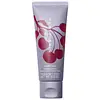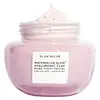What's inside
What's inside
 Key Ingredients
Key Ingredients

 Benefits
Benefits

 Concerns
Concerns

 Ingredients Side-by-side
Ingredients Side-by-side

Water
Skin ConditioningSucrose
HumectantGlycerin
HumectantHydrated Silica
AbrasiveDisodium Laureth Sulfosuccinate
CleansingDehydroxanthan Gum
Emulsion StabilisingSodium Lauroamphoacetate
CleansingPolyacrylate Crosspolymer-6
Emulsion StabilisingMaltodextrin
AbsorbentPolyglyceryl-10 Oleate
Skin ConditioningPropanediol
SolventMalpighia Punicifolia Fruit Extract
AntioxidantVaccinium Macrocarpon Fruit Extract
AstringentLactobacillus/Punica Granatum Fruit Ferment Extract
Skin ConditioningBromelain
Skin ConditioningPapain
Skin ConditioningCaffeine
Skin ConditioningCitric Acid
BufferingTocopherol
AntioxidantOryza Sativa Bran Extract
Skin ConditioningHelianthus Annuus Extract
EmollientRosmarinus Officinalis Leaf Extract
AntimicrobialRaphanus Sativus Root Extract
AstringentLeuconostoc/Radish Root Ferment Filtrate
AntimicrobialSodium Benzotriazolyl Butylphenol Sulfonate
UV AbsorberPentaerythrityl Tetra-Di-T-Butyl Hydroxyhydrocinnamate
AntioxidantCaprylyl Glycol
EmollientPhenoxyethanol
PreservativeChlorphenesin
AntimicrobialBenzoic Acid
MaskingSodium Benzoate
MaskingSodium Metabisulfite
AntioxidantSodium Hydroxide
BufferingParfum
MaskingCI 17200
Cosmetic ColorantCI 16035
Cosmetic ColorantWater, Sucrose, Glycerin, Hydrated Silica, Disodium Laureth Sulfosuccinate, Dehydroxanthan Gum, Sodium Lauroamphoacetate, Polyacrylate Crosspolymer-6, Maltodextrin, Polyglyceryl-10 Oleate, Propanediol, Malpighia Punicifolia Fruit Extract, Vaccinium Macrocarpon Fruit Extract, Lactobacillus/Punica Granatum Fruit Ferment Extract, Bromelain, Papain, Caffeine, Citric Acid, Tocopherol, Oryza Sativa Bran Extract, Helianthus Annuus Extract, Rosmarinus Officinalis Leaf Extract, Raphanus Sativus Root Extract, Leuconostoc/Radish Root Ferment Filtrate, Sodium Benzotriazolyl Butylphenol Sulfonate, Pentaerythrityl Tetra-Di-T-Butyl Hydroxyhydrocinnamate, Caprylyl Glycol, Phenoxyethanol, Chlorphenesin, Benzoic Acid, Sodium Benzoate, Sodium Metabisulfite, Sodium Hydroxide, Parfum, CI 17200, CI 16035
Water
Skin ConditioningGlycerin
HumectantKaolin
AbrasiveStearyl Alcohol
EmollientHydroxypropyl Starch Phosphate
Bentonite
AbsorbentCaprylic/Capric Triglyceride
MaskingGlyceryl Stearate Se
EmulsifyingCitrullus Lanatus Fruit Extract
Skin ConditioningGluconolactone
Skin ConditioningHydrated Silica
AbrasiveSea Water
HumectantSalix Alba Bark Extract
AstringentSodium Stearoyl Lactylate
EmulsifyingXanthan Gum
EmulsifyingLactobacillus/Watermelon Fruit Ferment Extract
Skin ConditioningSodium Hyaluronate
HumectantHydrolyzed Sodium Hyaluronate
Skin ConditioningBambusa Arundinacea Stem Extract
Skin ConditioningLycium Barbarum Fruit Extract
AstringentLeuconostoc/Radish Root Ferment Filtrate
AntimicrobialCaprylyl Glycol
Emollient1,2-Hexanediol
Skin ConditioningCitric Acid
BufferingMaltodextrin
AbsorbentEclipta Prostrata Extract
Skin ConditioningGlucose
HumectantSodium Phytate
Silica
AbrasiveMelia Azadirachta Leaf Extract
Skin ConditioningPotassium Sorbate
PreservativeHexylene Glycol
EmulsifyingMoringa Oleifera Seed Oil
EmollientVaccinium Corymbosum Seed
AbrasiveHydroxyacetophenone
AntioxidantCarrageenan
CI 77891
Cosmetic ColorantPhenoxyethanol
PreservativeParfum
MaskingWater, Glycerin, Kaolin, Stearyl Alcohol, Hydroxypropyl Starch Phosphate, Bentonite, Caprylic/Capric Triglyceride, Glyceryl Stearate Se, Citrullus Lanatus Fruit Extract, Gluconolactone, Hydrated Silica, Sea Water, Salix Alba Bark Extract, Sodium Stearoyl Lactylate, Xanthan Gum, Lactobacillus/Watermelon Fruit Ferment Extract, Sodium Hyaluronate, Hydrolyzed Sodium Hyaluronate, Bambusa Arundinacea Stem Extract, Lycium Barbarum Fruit Extract, Leuconostoc/Radish Root Ferment Filtrate, Caprylyl Glycol, 1,2-Hexanediol, Citric Acid, Maltodextrin, Eclipta Prostrata Extract, Glucose, Sodium Phytate, Silica, Melia Azadirachta Leaf Extract, Potassium Sorbate, Hexylene Glycol, Moringa Oleifera Seed Oil, Vaccinium Corymbosum Seed, Hydroxyacetophenone, Carrageenan, CI 77891, Phenoxyethanol, Parfum
 Reviews
Reviews

Ingredients Explained
These ingredients are found in both products.
Ingredients higher up in an ingredient list are typically present in a larger amount.
Caprylyl Glycol is a humectant and emollient, meaning it attracts and preserves moisture.
It is a common ingredient in many products, especially those designed to hydrate skin. The primary benefits are retaining moisture, skin softening, and promoting a healthy skin barrier.
Though Caprylyl Glycol is an alcohol derived from fatty acids, it is not the kind that can dry out skin.
This ingredient is also used as a preservative to extend the life of products. It has slight antimicrobial properties.
Learn more about Caprylyl GlycolCitric Acid is an alpha hydroxy acid (AHA) naturally found in citrus fruits like oranges, lemons, and limes.
Like other AHAs, citric acid can exfoliate skin by breaking down the bonds that hold dead skin cells together. This helps reveal smoother and brighter skin underneath.
However, this exfoliating effect only happens at high concentrations (20%) which can be hard to find in cosmetic products.
Due to this, citric acid is usually included in small amounts as a pH adjuster. This helps keep products slightly more acidic and compatible with skin's natural pH.
In skincare formulas, citric acid can:
While it can provide some skin benefits, research shows lactic acid and glycolic acid are generally more effective and less irritating exfoliants.
Most citric acid used in skincare today is made by fermenting sugars (usually from molasses). This synthetic version is identical to the natural citrus form but easier to stabilize and use in formulations.
Read more about some other popular AHA's here:
Learn more about Citric AcidGlycerin is already naturally found in your skin. It helps moisturize and protect your skin.
A study from 2016 found glycerin to be more effective as a humectant than AHAs and hyaluronic acid.
As a humectant, it helps the skin stay hydrated by pulling moisture to your skin. The low molecular weight of glycerin allows it to pull moisture into the deeper layers of your skin.
Hydrated skin improves your skin barrier; Your skin barrier helps protect against irritants and bacteria.
Glycerin has also been found to have antimicrobial and antiviral properties. Due to these properties, glycerin is often used in wound and burn treatments.
In cosmetics, glycerin is usually derived from plants such as soybean or palm. However, it can also be sourced from animals, such as tallow or animal fat.
This ingredient is organic, colorless, odorless, and non-toxic.
Glycerin is the name for this ingredient in American English. British English uses Glycerol/Glycerine.
Learn more about GlycerinHydrated Silica is a type of silicon dioxide. It is called 'hydrated silica' because it is silica with extra bonded water atoms.
It is an absorbent and abrasive, meaning it is exfoliating.
Silica is often used for absorption and can help reduce shine when products are applied.
Learn more about Hydrated SilicaLeuconostoc/Radish Root Ferment Filtrate is a natural preservative. It comes from fermenting radish roots with a bacteria called leuconostoc.
Leuconostoc comes from lactic acid.
This ingredient has antimicrobial properties and helps prevent the growth of bacteria in a product.
Leuconostoc is used to make the traditional Korean side-dish, kimchi. It is also used to make sourdough bread (both incredibly yummy foods).
Learn more about Leuconostoc/Radish Root Ferment FiltrateMaltodextrin is a polysaccharide. It is derived from starch such as rice, corn, wheat, or potato starch.
In food, Maltodextrin is used to improve the texture and thicken a product. Due to its structure, it can help create a gel texture. As an emulsion stabilizer, it helps keep the ingredients in a product together.
As a polysaccharide, Maltodextrin has moisturizing properties. Polysaccharides are a type of carbohydrate. The top layer of skin uses polysaccharides to retain water, keeping the skin hydrated.
Maltodextrin is water soluble and has a sweet taste.
Learn more about MaltodextrinParfum is a catch-all term for an ingredient or more that is used to give a scent to products.
Also called "fragrance", this ingredient can be a blend of hundreds of chemicals or plant oils. This means every product with "fragrance" or "parfum" in the ingredients list is a different mixture.
For instance, Habanolide is a proprietary trade name for a specific aroma chemical. When used as a fragrance ingredient in cosmetics, most aroma chemicals fall under the broad labeling category of “FRAGRANCE” or “PARFUM” according to EU and US regulations.
The term 'parfum' or 'fragrance' is not regulated in many countries. In many cases, it is up to the brand to define this term.
For instance, many brands choose to label themselves as "fragrance-free" because they are not using synthetic fragrances. However, their products may still contain ingredients such as essential oils that are considered a fragrance by INCI standards.
One example is Calendula flower extract. Calendula is an essential oil that still imparts a scent or 'fragrance'.
Depending on the blend, the ingredients in the mixture can cause allergies and sensitivities on the skin. Some ingredients that are known EU allergens include linalool and citronellol.
Parfum can also be used to mask or cover an unpleasant scent.
The bottom line is: not all fragrances/parfum/ingredients are created equally. If you are worried about fragrances, we recommend taking a closer look at an ingredient. And of course, we always recommend speaking with a professional.
Learn more about ParfumPhenoxyethanol is a preservative that has germicide, antimicrobial, and aromatic properties. Studies show that phenoxyethanol can prevent microbial growth. By itself, it has a scent that is similar to that of a rose.
It's often used in formulations along with Caprylyl Glycol to preserve the shelf life of products.
Water. It's the most common cosmetic ingredient of all. You'll usually see it at the top of ingredient lists, meaning that it makes up the largest part of the product.
So why is it so popular? Water most often acts as a solvent - this means that it helps dissolve other ingredients into the formulation.
You'll also recognize water as that liquid we all need to stay alive. If you see this, drink a glass of water. Stay hydrated!
Learn more about Water